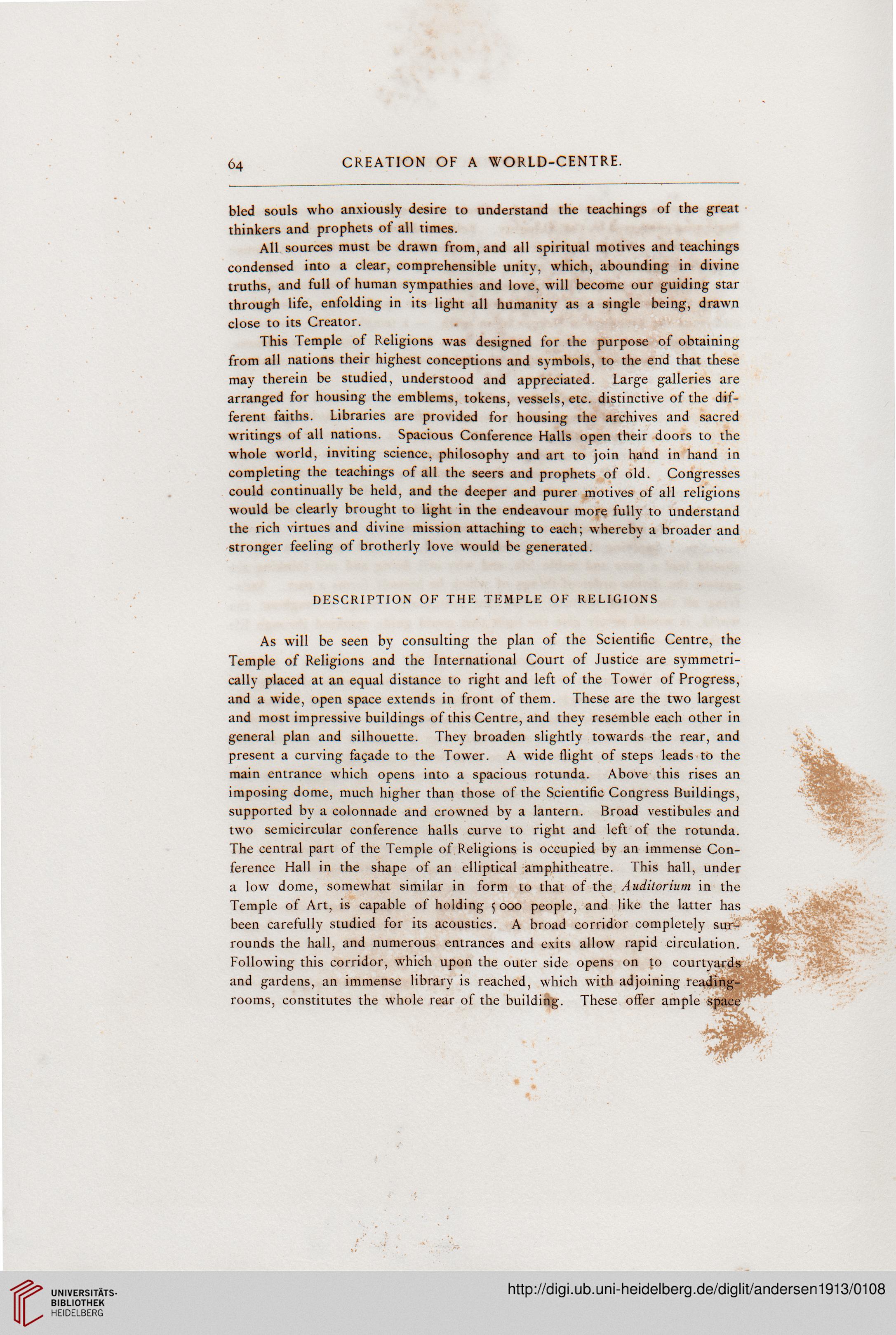64
CREATION OF A WORLD-CENTRE.
bled souls who anxiously desire to understand the teachings of the great
thinkers and prophets of all times.
All sources must be drawn from, and all spiritual motives and teachings
condensed into a clear, comprehensible unity, which, abounding in divine
truths, and full of human sympathies and love, will become our guiding star
through life, enfolding in its light all humanity as a single being, drawn
close to its Creator.
This Temple of Religions was designed for the purpose of obtaining
from all nations their highest conceptions and symbols, to the end that these
may therein be studied, understood and appreciated. Large galleries are
arranged for housing the emblems, tokens, vessels, etc. distinctive of the dif-
ferent faiths. Libraries are provided for housing the archives and sacred
writings of all nations. Spacious Conference Halls open their doors to the
whole world, inviting science, philosophy and art to join hand in hand in
completing the teachings of all the seers and prophets of old. Congresses
could continually be held, and the deeper and purer motives of all religions
would be clearly brought to light in the endeavour more fully to understand
the rich virtues and divine mission attaching to each; whereby a broader and
stronger feeling of brotherly love would be generated.
DESCRIPTION OF THE TEMPLE OF RELIGIONS
As will be seen by consulting the plan of the Scientific Centre, the
Temple of Religions and the International Court of Justice are symmetri-
cally placed at an equal distance to right and left of the Tower of Progress,
and a wide, open space extends in front of them. These are the two largest
and most impressive buildings of this Centre, and they resemble each other in
general plan and silhouette. They broaden slightly towards the rear, and
present a curving fagade to the Tower. A wide flight of steps leads to the
main entrance which opens into a spacious rotunda. Above this rises an
imposing dome, much higher than those of the Scientific Congress Buildings,
supported by a colonnade and crowned by a lantern. Broad vestibules and
two semicircular conference halls curve to right and left of the rotunda.
The central part of the Temple of Religions is occupied by an immense Con-
ference Hall in the shape of an elliptical amphitheatre. This hall, under
a low dome, somewhat similar in form to that of the Auditorium in the
Temple of Art, is capable of holding $ ooo people, and like the latter has
been carefully studied for its acoustics. A broad corridor completely sur-
rounds the hall, and numerous entrances and exits allow rapid circulation.
Following this corridor, which upon the outer side opens on to court
and gardens, an immense library is reached, which with adjoining reading
rooms, constitutes the whole rear of the building. These offer ample space
CREATION OF A WORLD-CENTRE.
bled souls who anxiously desire to understand the teachings of the great
thinkers and prophets of all times.
All sources must be drawn from, and all spiritual motives and teachings
condensed into a clear, comprehensible unity, which, abounding in divine
truths, and full of human sympathies and love, will become our guiding star
through life, enfolding in its light all humanity as a single being, drawn
close to its Creator.
This Temple of Religions was designed for the purpose of obtaining
from all nations their highest conceptions and symbols, to the end that these
may therein be studied, understood and appreciated. Large galleries are
arranged for housing the emblems, tokens, vessels, etc. distinctive of the dif-
ferent faiths. Libraries are provided for housing the archives and sacred
writings of all nations. Spacious Conference Halls open their doors to the
whole world, inviting science, philosophy and art to join hand in hand in
completing the teachings of all the seers and prophets of old. Congresses
could continually be held, and the deeper and purer motives of all religions
would be clearly brought to light in the endeavour more fully to understand
the rich virtues and divine mission attaching to each; whereby a broader and
stronger feeling of brotherly love would be generated.
DESCRIPTION OF THE TEMPLE OF RELIGIONS
As will be seen by consulting the plan of the Scientific Centre, the
Temple of Religions and the International Court of Justice are symmetri-
cally placed at an equal distance to right and left of the Tower of Progress,
and a wide, open space extends in front of them. These are the two largest
and most impressive buildings of this Centre, and they resemble each other in
general plan and silhouette. They broaden slightly towards the rear, and
present a curving fagade to the Tower. A wide flight of steps leads to the
main entrance which opens into a spacious rotunda. Above this rises an
imposing dome, much higher than those of the Scientific Congress Buildings,
supported by a colonnade and crowned by a lantern. Broad vestibules and
two semicircular conference halls curve to right and left of the rotunda.
The central part of the Temple of Religions is occupied by an immense Con-
ference Hall in the shape of an elliptical amphitheatre. This hall, under
a low dome, somewhat similar in form to that of the Auditorium in the
Temple of Art, is capable of holding $ ooo people, and like the latter has
been carefully studied for its acoustics. A broad corridor completely sur-
rounds the hall, and numerous entrances and exits allow rapid circulation.
Following this corridor, which upon the outer side opens on to court
and gardens, an immense library is reached, which with adjoining reading
rooms, constitutes the whole rear of the building. These offer ample space





